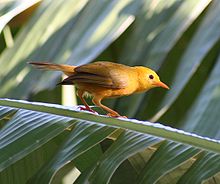Cleptornis
| Golden white-eye | |
|---|---|
 |
|
| Scientific classification | |
| Kingdom: | Animalia |
| Phylum: | Chordata |
| Class: | Aves |
| Order: | Passeriformes |
| Family: | Zosteropidae |
| Genus: |
Cleptornis Oustalet, 1889 |
| Species: | C. marchei |
| Binomial name | |
|
Cleptornis marchei (Oustalet, 1889) |
|
| Synonyms | |
|
Ptilotis marchei |
|
Ptilotis marchei
The golden white-eye (Cleptornis marchei) is a species of bird in the white-eye family Zosteropidae. It is the only species within the genus Cleptornis. The golden white-eye was once considered to be a honeyeater in the family Meliphagidae and although it is now known to be a white-eye, its position within that family is still uncertain. The species is restricted to the islands of Saipan and Aguijan in the Northern Mariana Islands, where it is sympatric (shares its range) and competes with the related bridled white-eye. The golden white-eye has golden plumage and a pale eye-ring. It feeds on insects, fruit, and nectar and forages in pairs or small family groups. The bird is monogamous and lays two eggs in a small cup nest.
Fossil evidence shows the golden white-eye once also occurred on Tinian and Rota but was extirpated in those locations through the impact of human activities. Despite its current abundance on Saipan and Aguijan, and the fact that it has among the highest recorded densities for any bird, it is nevertheless considered to be critically endangered. It is threatened by the invasive brown tree snake, which has become established on nearby Guam, and this predator is expected to cause a rapid decline in the population if it reaches Saipan. Efforts are under way to control the snakes and breed the white-eye in zoos.
...
Wikipedia

